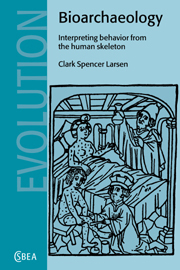Book contents
- Frontmatter
- Contents
- Acknowledgments
- 1 Introduction
- 2 Stress and deprivation during the years of growth and development and adulthood
- 3 Exposure to infectious pathogens
- 4 Injury and violent death
- 5 Activity patterns: 1. Articular and muscular modifications
- 6 Activity patterns: 2. Structural adaptation
- 7 Masticatory and nonmasticatory functions: craniofacial adaptation
- 8 Isotopic and elemental signatures of diet and nutrition
- 9 Historical dimensions of skeletal variation: tracing genetic relationships
- 10 Changes and challenges in bioarchaeology
- References
- General index
- Site index
3 - Exposure to infectious pathogens
Published online by Cambridge University Press: 05 June 2012
- Frontmatter
- Contents
- Acknowledgments
- 1 Introduction
- 2 Stress and deprivation during the years of growth and development and adulthood
- 3 Exposure to infectious pathogens
- 4 Injury and violent death
- 5 Activity patterns: 1. Articular and muscular modifications
- 6 Activity patterns: 2. Structural adaptation
- 7 Masticatory and nonmasticatory functions: craniofacial adaptation
- 8 Isotopic and elemental signatures of diet and nutrition
- 9 Historical dimensions of skeletal variation: tracing genetic relationships
- 10 Changes and challenges in bioarchaeology
- References
- General index
- Site index
Summary
Introduction
For the entire history of humankind, populations were exposed to numerous infectious agents – bacteria and viruses – resulting in a range of disease states. Anthropologists, paleopathologists, and others have documented and described the dental and skeletal evidence for some of these diseases (see Buikstra & Cook, 1980; Ortner & Putschar, 1985; Steinbock, 1976). Although largely confined to descriptive reports and case diagnoses, newer studies emphasize biocultural perspectives of disease in relation to social, cultural, and environmental circumstances (Buikstra & Cook, 1980; Larsen, 1987; Ubelaker, 1982).
Infection by a pathogen does not always result in disease. The progression from infection to disease depends on agent pathogenicity, transmission route from agent to host, and the strength and nature of the response of the host (see Inhorn & Brown, 1990; Smith & Moss, 1994). Many acute infectious diseases or epidemics result in death of the infected individual soon after microbial attack. These infectious diseases leave no skeletal evidence, clouding the full picture of disease and its relationship to mortality in past populations. Alternatively, several chronic infectious diseases affect osseous tissues in patterned ways. Despite the interpretive drawbacks, the study of bone lesions documenting disease provides an important perspective on health in earlier societies.
- Type
- Chapter
- Information
- BioarchaeologyInterpreting Behavior from the Human Skeleton, pp. 64 - 108Publisher: Cambridge University PressPrint publication year: 1997



